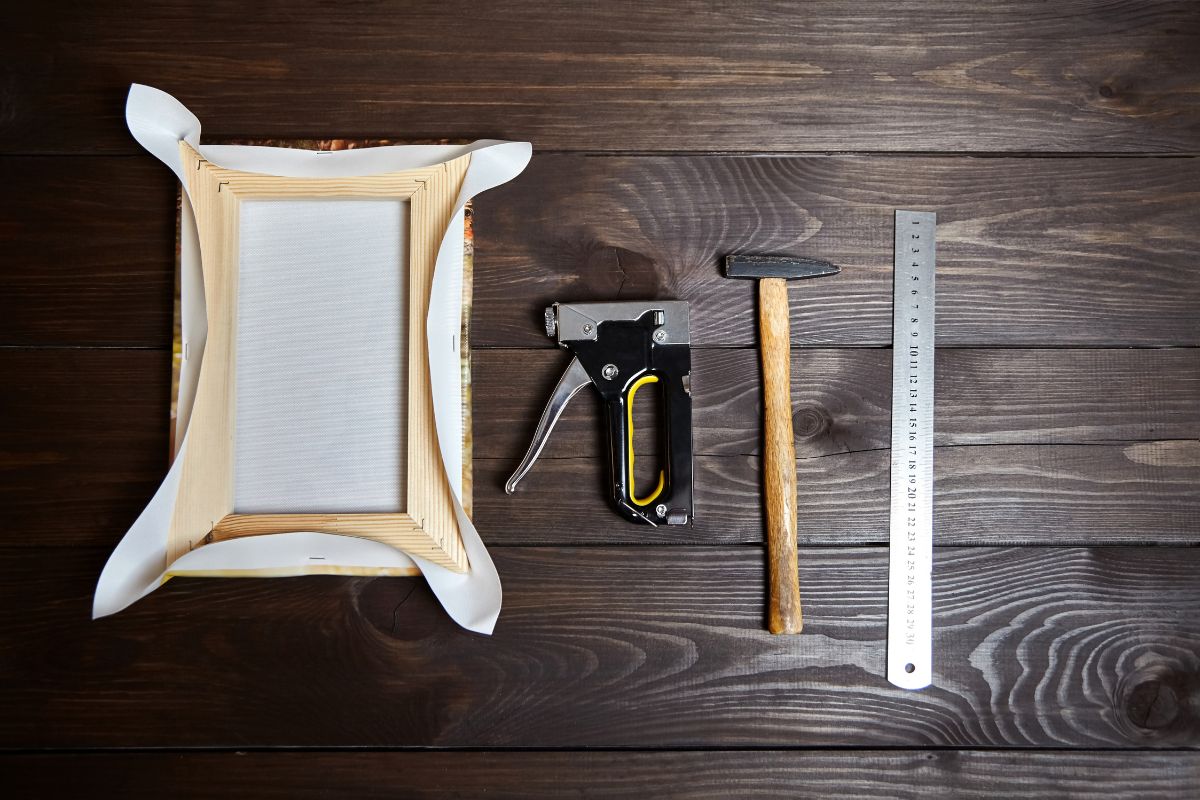Key Takeaways
- Rolled canvas costs 30-50% less than stretched canvas but requires professional stretching
- Stretched canvas offers immediate display convenience and professional presentation
- Professional stretching costs $8-20 per linear foot depending on size and complexity
- Rolled canvases are safer for international shipping and long-distance transport
When it comes to displaying canvas art, one of the biggest decisions you'll need to make is whether to go with a rolled or stretched canvas. Each option has its own unique set of benefits and drawbacks, and the right choice for you will depend on your specific needs and preferences. After 15 years in the art and décor industry, I've guided countless clients through this decision, and I'll share everything you need to know to make the right choice for your situation.

Visual comparison: stretched canvas ready for display vs. rolled canvas requiring assembly
What is a Rolled Canvas?
A rolled canvas is a canvas that is shipped to you in a rolled-up form, rather than stretched over a frame. This method has been the preferred shipping method for galleries and museums for decades due to its practical advantages. According to art collectors on Reddit, "rolled is much safer as the cylindrical tubes are virtually indestructible" and is typically how galleries receive canvases from artists.
Rolled canvases are typically more affordable than stretched canvases and are easier to store and transport. They are also great for artists who want to stretch the canvas themselves or have it stretched locally. However, this option requires additional steps and expertise to achieve a professional result.

Professional packaging: rolled canvas delivery in protective tube
What is a Stretched Canvas?
A stretched canvas is a canvas that has been stretched over a frame and is ready to be displayed as is. Stretched canvases are more expensive than rolled canvases, but they are also more convenient, as they are ready to be hung on the wall as soon as you receive them. This option is perfect for those who want immediate gratification and professional presentation without the hassle of finding a local framer.
Professional stretched canvases typically use gallery-quality stretcher bars and precise tensioning to ensure the artwork maintains its integrity over time. The stretching process requires specialized knowledge to avoid damaging the artwork and achieve proper tension distribution.
Professional presentation: stretched canvas immediately ready for display
How Does Canvas Stretching Work?
Stretching a canvas involves pulling the canvas taut over a frame and securing it in place. This process requires precision and experience to achieve professional results. The first step is to lay the canvas face down on a clean, flat surface. The canvas is then centered over the stretcher frame, ensuring equal margins on all sides.
The corners of the canvas are then folded over the frame and secured with staples or tacks. The canvas is adjusted and tightened until it is taut and evenly stretched. Professional framers use specialized tools like canvas pliers to achieve the proper tension without damaging the artwork.
Professional Canvas Stretching Tutorial
Watch this comprehensive tutorial from Jackson's Art showing the complete process from tools to finished canvas:
Cost Analysis: What You Need to Know
One of the most significant factors in choosing between rolled and stretched canvas is cost. Based on industry data and my experience working with clients, here's what you can expect:
Rolled Canvas Costs
Rolled canvas prints typically cost 30-50% less than their stretched counterparts. However, you'll need to factor in stretching costs. According to Breathing Color, professional stretching services range from $8-20 per linear foot, with total costs typically falling between $50-150 per print depending on size and complexity.
Stretched Canvas Investment
While stretched canvases have a higher upfront cost, they eliminate the need for additional services and provide immediate display capability. For many clients, the convenience factor justifies the premium, especially for larger pieces where professional stretching costs can be substantial.
Cost-Effective Canvas Options: Explore our collection of professionally prepared canvas prints that balance quality and value:
- Abstract Wall Art Prints - Modern designs perfect for contemporary spaces
- Vintage Landscape Prints - Classic appeal with timeless subjects
- Contemporary Art Prints - Cutting-edge designs for modern interiors
What Tools Do You Need to Stretch a Canvas?
If you're considering the DIY route for stretching your rolled canvas, you'll need specific tools and materials. Here's the complete list based on professional recommendations:
Essential Tools
- Canvas stretcher bars or wooden frame
- Heavy-duty staple gun with 1/4" staples
- Canvas pliers (highly recommended for proper tension)
- Measuring tape and pencil
- Utility knife or canvas cutter
- Canvas keys (wooden wedges for tension adjustment)
Workspace Requirements
You'll also need a clean, flat, stable surface to work on, such as a large table or workbench. The workspace should be dust-free to avoid contaminating the artwork surface. Professional framers recommend working in a space at least twice the size of your canvas to allow proper maneuvering.
Storage and Shipping Considerations
One area where rolled canvas significantly outperforms stretched canvas is in storage and shipping. This advantage becomes particularly important for international purchases, large collections, or frequent relocations.
Shipping Advantages
Tribeca Printworks notes that if you collect art from around the globe, rolled canvas prints are ideal because they "tuck easily inside suitcases and ship safely from abroad." The cylindrical tubes provide excellent protection against impact and environmental factors during transit.
Storage Solutions
For collectors with limited space, rolled canvases offer significant storage advantages. They can be stored vertically in tubes, taking up minimal floor space. However, proper storage is crucial to prevent damage. The Canadian Conservation Institute recommends storing canvases in acid-free tubes with proper climate control.

The importance of proper storage: damaged vs. well-preserved canvas comparison
Should Canvas Paintings Be Framed?
Whether or not you should frame a canvas painting is largely a matter of personal preference and the specific artwork. Some people prefer the clean, finished look of a framed canvas, while others prefer the more contemporary, gallery-style appearance of an unframed stretched canvas.
Benefits of Framing
Framing a canvas can protect the edges of the painting from damage and dirt, and it can also add a level of sophistication and formality to the piece. Traditional frames work particularly well with vintage landscape artwork and classic masterpiece reproductions.
Modern Display Trends
Contemporary gallery practices often favor unframed stretched canvases, especially for modern contemporary pieces and abstract artwork. This approach emphasizes the artwork itself and creates a cleaner, more minimalist aesthetic that works well in modern interiors.
Display Options for Different Spaces
The way you choose to display your canvas art can dramatically impact your space's overall aesthetic. Here are professional recommendations for different environments:
Living Rooms and Main Areas
- Hang stretched canvases at eye level (57-60 inches from floor to center of artwork)
- Create gallery walls with multiple pieces using consistent spacing
- Consider lighting to highlight texture and colors
Alternative Display Methods
- Lean large canvases against walls for a casual, contemporary look
- Use easels for smaller pieces in studios or reading areas
- Install track systems for frequently changing displays
When to Buy Rolled vs Stretched Canvas Art
Based on my experience helping clients choose the right option, here are the key decision factors:
Choose Rolled Canvas When:
- Budget is a primary concern (30-50% cost savings)
- You have access to quality local framing services
- You're purchasing art internationally or need to ship long distances
- You want flexibility in final sizing or cropping
- You're building a large collection and need efficient storage
- You enjoy DIY projects and have the necessary tools and skills
Choose Stretched Canvas When:
- Immediate display is important (ready to hang upon arrival)
- You don't have access to quality framing services
- The piece is a gift or for a specific deadline
- You prefer professional results without the hassle
- The artwork will be displayed in a high-visibility professional setting
- You're purchasing a single statement piece rather than building a collection
Expert Recommendation: For first-time buyers, I often recommend starting with a stretched canvas to experience the immediate satisfaction of display. As you become more involved in collecting, rolled canvases offer better value for building larger collections, especially when you develop relationships with quality local framers.
Professional Tips from 15 Years in the Industry
After helping hundreds of clients make this decision, here are some insights that can save you time, money, and frustration:
Quality Indicators
When purchasing rolled canvas, ask about the canvas weight (measured in ounces per square yard). Professional-grade canvases typically range from 10-16 oz, with heavier weights providing better durability and professional appearance. Also inquire about the ink type - pigment-based inks offer superior longevity compared to dye-based alternatives.
Avoiding Common Mistakes
One mistake I see frequently is clients attempting to stretch large canvases (over 30 inches) without proper experience. Large formats require specific techniques and tools to achieve even tension. For pieces over 24x36 inches, I strongly recommend professional stretching unless you have significant experience.
Building Relationships with Local Framers
If you choose the rolled canvas route, develop a relationship with a quality local framer. Many offer volume discounts for repeat customers, and they can provide valuable advice on stretcher bar options, hanging systems, and display techniques.
Conclusion
The choice between rolled and stretched canvas ultimately depends on your specific needs, budget, and preferences. Rolled canvas offers significant cost savings and shipping advantages but requires additional steps to achieve display-ready results. Stretched canvas provides immediate convenience and professional presentation at a premium price point.
Consider your long-term collecting goals, available resources, and display timeline when making this decision. Both options can result in beautiful, professional-quality displays when chosen appropriately for your situation.
Ready to Choose Your Perfect Canvas? Explore our curated collections featuring both rolled and stretched options:
- Photography Wall Art Prints - Stunning detail perfect for any format
- Botanical Wall Art Prints - Natural beauty for any space
- Vintage Illustration Prints - Timeless designs with classic appeal
As you make your decision, remember that both rolled and stretched canvases can create stunning displays when chosen thoughtfully. The most important factor is selecting artwork that speaks to you and enhances your living space, regardless of the format you choose.

Nikki Sandeman
Art Lover & Décor Specialist
With a 15-year journey renovating homes and styling living spaces with unique wall art and custom prints, I specialize in helping readers integrate art and décor into modern interiors. Learn more →









